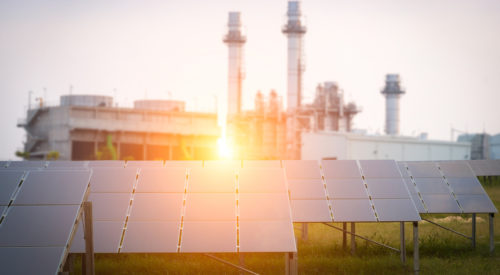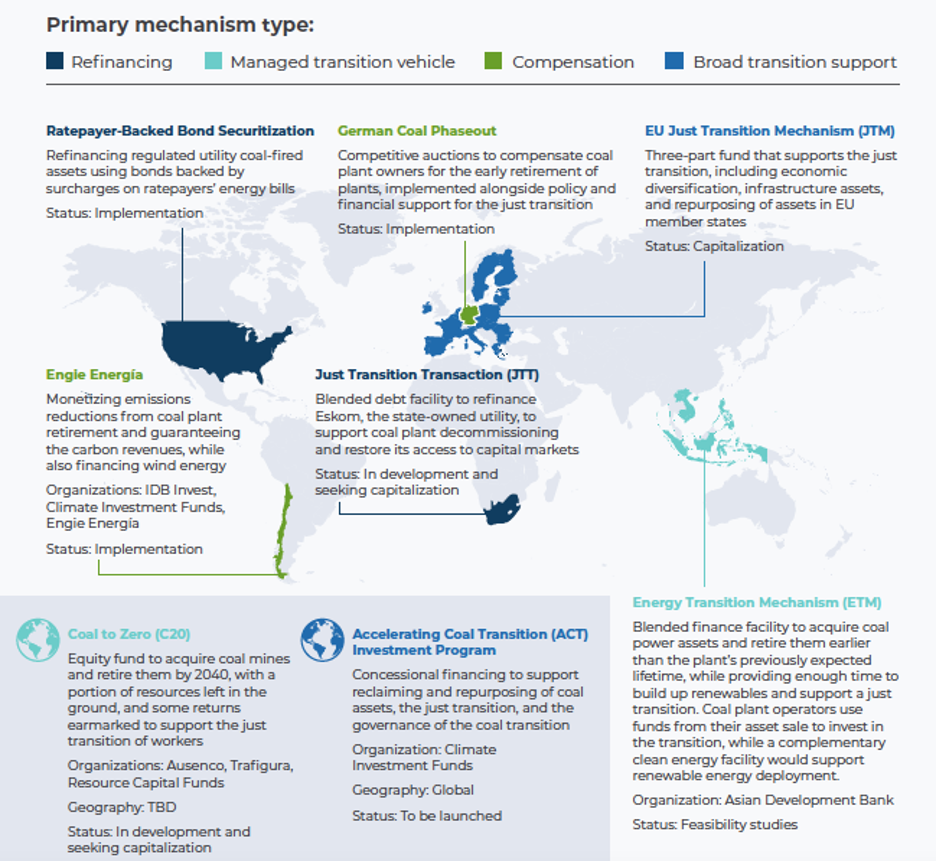Solar panels and Electric power plant by gas background.

Climate Finance 101: Demystifying Financial Mechanisms for the Global Coal Transition
Transitioning away from coal is one of this year’s biggest topics at COP26 in Glasgow, from more ambitious coal phaseout commitments by governments to Michael Bloomberg’s announcement of a new effort to close a quarter of the world’s coal plants. Alongside this ambition, we’ve seen the launch of several innovative financial mechanisms to help deliver a rapid, smooth, and equitable coal transition. These include $8.5 billion in funding to the Just Energy Transition Partnership to drive a just coal transition in South Africa; the Asian Development Bank’s Energy Transition Mechanism to accelerate the coal transition in Indonesia and the Philippines; the Climate Investment Funds’ Accelerating Coal Transition Investment Program; and the launch of the Coal Asset Transition Accelerator, a new platform to support the use of finance in the coal transition.
These announcements are coming after a year in which financial mechanisms are increasingly front and center on the coal transition agenda. In the United States, regulators authorized over $1.5 billion in securitization transactions to support the retirement and replacement of coal, while the chief executive of the world’s largest financial institution suggested the world needs a “bad bank” to wind down coal assets.
Yet with all the buzz around financial mechanisms for the coal transition, it’s worthwhile to take a step back to understand: Just what are financial mechanisms and why do they matter? RMI’s latest report, Financing the Coal Transition, provides a detailed analysis for both why and how finance can be used to accelerate the coal transition, but let’s unpack the basics here.
We Can’t Just Let the Market Take Care of Coal
The cost of clean energy is falling rapidly, and new renewables plus storage are already able to cost-effectively replace 39 percent of global existing coal plants. But here’s the catch: 93 percent of coal plants operate in markets where they are shielded from competitive pressure of cheaper and cleaner energy, whether through contracts such as power purchase agreements (PPAs), regulated electricity tariffs that provide “guaranteed” returns, or fossil fuel subsidies. This means the lion’s share of coal plants will continue to operate long after they cease to be economic, with most of their costs passed directly onto electricity customers and taxpayers and indirectly onto the health of local populations and the climate.
This is where financial mechanisms come in. Financial mechanisms can address the contractual or structural barriers that keep uneconomic plants operating, while managing impacts on the most vulnerable stakeholders. By sharing the risks and benefits of the coal transition across different stakeholders, financial mechanisms can align incentives of governments, companies, and communities to enable progress on the coal transition today. When designed well, financial mechanism can enable a coal transition that is:
- Rapid, pragmatically targeting the early retirement of plants that otherwise would continue to operate;
- Equitable, reducing the costs and burden of uneconomic coal on the general public while addressing the needs of workers; and
- Smooth, ensuring that barriers to the coal transition are addressed without compromising future energy transition efforts.
How Financial Mechanisms Work: A Look Behind the Curtain
While they may seem like magic, financial mechanisms tend to rely on similar key principles: reducing or transferring the obligation to continue to pay for uneconomic coal, with the goals of reducing costs for the public, enabling a faster transition from coal to clean, and supporting a just transition of workers. Coal transition financial mechanisms already come in many different flavors (see Exhibit below), and it’s a space where we’re likely to see continued innovation. But let’s look at how some of these ideas are already playing out.
Securitization: securitization is a refinancing mechanism gaining momentum in US regulated utility markets, where utilities are allowed to build in a fair return on investment into their electricity tariffs. In a growing number of US states, utilities can issue securitization bonds backed by surcharges on customer bills, which 1) refinance electricity customers’ obligation to pay the utility a full return on its (uneconomic) coal assets, with an obligation to repay a much lower-cost bond; 2) provide transition assistance for communities affected by the coal transition; and 3) enable capital recovery for the utility, which it can reinvest in clean energy.
In this way, securitization reduces the obligation of customers to pay for coal, while minimizing the impacts of an unmanaged transition. For example, if a utility is forced to shutter its plants without capital recovery, it not only may negatively impact workers, but could also affect its creditworthiness, making energy more expensive for customers in the long run.
Energy Transition Mechanism (ETM): The ETM is a public-private finance vehicle announced by the Asian Development Bank that aims to accelerate the retirement of coal plants in developing countries—with an initial focus on Indonesia, the Philippines, and Vietnam—and to boost the growth of renewable energy. As part of the ETM, a Carbon Reduction Facility will purchase coal plants with the goal of retiring them before their business-as-usual end of life. The lower cost of capital of the blended finance ETM will allow it to utilize the coal plant’s cash flows to repay investors faster than an owner with a higher cost of capital, enabling the ETM to accelerate the plant’s retirement. As a result, the ETM uses public finance to reduce the obligation—whether through a PPA, electricity tariffs, or fossil fuel subsidies—for utilities, customers, and taxpayers to continue paying for costly coal generation.
Engie Energía Chile: Engie Energía Chile, together with Inter-American Development Bank Invest and Climate Investment Funds, is implementing a financial mechanism that monetizes the emissions reduction from the early retirement of its coal plants. This mechanism allows Engie to receive compensation for the early closure of its coal plants in the form of results-based public finance, or carbon finance, which is built in as an interest rate reduction in a financial package to Engie. In this way, carbon finance transfers the cost of uneconomic coal from customers to public funders.
What’s Next
While the momentum behind financial mechanisms is exciting, we should remember that financial mechanisms are not a silver bullet. Their credibility and effectiveness will hinge on how they are designed, implemented, and governed to deliver an equitable coal transition. As we move from conceptualization to implementation, it will be critical that we get them right. Read RMI’s latest report for more information on how to finance the coal transition, including key principles to safeguard their credibility.
